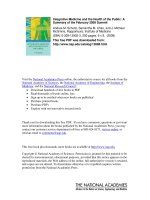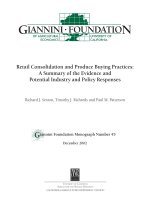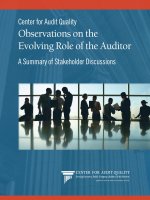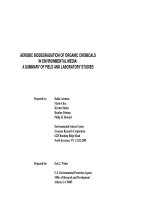1 a summary of APA style
Bạn đang xem bản rút gọn của tài liệu. Xem và tải ngay bản đầy đủ của tài liệu tại đây (285.14 KB, 10 trang )
APA Style 1
A summary of APA Style
I. FORMATTING MANUSCRIPT
1. Margins: Leave at least one inch (2.5 cm) on all sides.
2. Justification: Left-justify the document, leaving the right margin ragged.
3. Typeface: Use a serif typeface such as 10 to 12-point Times New Roman, Palatino, Courier, or VNI-Times
4. Line Spacing: Double-space the entire paper including quotations, reference list, author identification notes, content footnotes, figure captions, and all parts of
tables. Long papers may use 1.5 spacing.
5. Page Headers and Page Numbers: A page header consists of the first two or three words of the title and serves as identification in case pages are separated.
Place the page header and the page number in the upper right corner of the page, e.g. Application Results 1
6. Paragraph Indentation: Indent the first line of each paragraph five to seven spaces (or half an inch). The remaining text of the essay should be left-justified.
7. Long quotations (block quotes):
Place direct quotations longer than 2 lines in a free-standing block of typewritten lines.
Omit quotation marks. Block quotations are often introduced with a colon (:).
Start the quotation on a new line, indented five spaces (or ½ inch) from the left margin without the usual opening paragraph indent.
Example:
… Jones's 1993 study found the following:
Students often had difficulty using APA style, especially when it was their first time citing sources. This difficulty could be attributed to the fact that many students
failed to purchase a style manual or to ask their teacher for help. (p. 199)
8. Headings
APA headings follow a hierarchy.
Using different levels of heading helps reveal the organization of the paper.
=> Levels of heading
CENTERED UPPERCASE HEADING
Level 5
Centered Uppercase and Lowercase Heading
Level 1
Centered, Italicized, Uppercase and Lowercase Heading
Level 2
Flush left, Italicized, Uppercase and Lowercase Side Heading
Indented, italicized, lowercase paragraph heading, ending with a period.
Example:
Level 3
Level 4
APA Style 2
AN INTERVIEW VALIDATION STUDY
Level 5
External Validation
Level 1
Method
Level 2
Sample and Procedures
Participants and interview sheets.
NOTES:
- Do not precede headings with numbers (I, II, 1, 2,…) or letters (A, B, a, b,…).
- Level 4 ends with a period although it might not be a complete sentence.
=> Choice of levels of heading
Few papers require all 5 levels of heading. Three-level heading is the most common.
- One level (for a short article) use level 1
- Two levels
use level 1 & level 3 (or level 4)
- Three levels
use level 1, level 3, and level 4
- Four levels
use level 1, level 2, level 3, and level 4
II. WRITING PARENTHETICAL CITATIONS
Examples
As Shrensky (1995) has noted in an earlier paper, poodles can be taught to sing (p. 25).
Shrensky (1995) demonstrates that poodles can be taught to sing (p. 25).
Miniature poodles can be taught to sing (Shrensky, 1995, p. 25).
Shrensky (1995) alleges/claims that poodles can sing (p. 25).
According to Wilson and Collins (1999), Shrensky's study is nonsense (p. 50).
Wilson and Collins (1999) say that Shrensky's study is nonsense (p. 50).
III. WRITING REFERENCES
Here are approved abbreviations for use in a reference list:
Level 3
Level 4
APA Style 3
chap. for chapter
ed. for edition
rev. ed. for revised edition
2nd ed. for second edition
Ed. for Edited by
(Eds.) for multiple editors
Trans. for Translated by
p. for page number, with a space after the
period
pp. for page numbers (plural)
Vol. for a specific Volume
vols. for a work with xx volumes
No. for Number
Pt. for Part
Suppl. for Supplement,
Tech. Rep. for Technical Report
n.d. for no date
n.p. for no page
IN-TEXT CITATION
REFERENCES
1. Book, one author
Chitty, D. (1996). Do lemmings commit suicide? Beautiful hypotheses and ugly facts. New
… (Chitty, 1996, p.28).
Chitty (1996) claimed that sources of facts about lemmings are
York: Oxford University Press.
unreliable (p. 28).
2. Book, two authors
…(Rosellini & Worden, 1997, pp. 123-146)
… As Rosellini and Worden (1997) suggested…
Rosellini, G., & Worden, M. (1997). Of course you're angry: A guide to dealing with the
emotions of substance abuse (Rev. ed.). Center City, MN: Hazelden.
3. Book, 3 to 5 authors
Booth, W. C., Colomb, G. G., & Williams, J. M. (1995). The craft of research. Chicago:
- First citation:
Common people may wonder whether doing research is an art (Booth,
University of Chicago Press.
Colomb, & Williams, 1995).
- Next citation:
… In fact, research skills are many and researchers need to be trained
(Booth et al., 1995).
4. Book, more than 6 authors
… (Jones et al., 2000).
As Jones et al. (2000) demonstrated, …
Jones, J.J, Wilson, K.M., Carr, K.L., Clark, J.F., Hudson, L.R., Jacobs, R.D., et al. (2000).
An introduction to linguistics. Oxford: Oxford University Press.
5. Book, corporate author
- First citation
- Corporate author is not the publisher
APA Style 4
The number of patients with mental disorders is reported increasing
(American Psychiatric Association [APA], 1990).
- Next citation
… Scientists have suggested some solutions to the problem (APA,
1990).
Children's Express. (1993). Voices from the future: Our children tell us about violence in
America. New York: Crown.
- Corporate author is the publisher
American Psychiatric Association. (1990). Diagnostic and statistical manual of mental
disorders (3rd ed.). Washington, DC: Author.
6. Unknown author
Many reports have been made on the relationship between mental
Caffeine linked to mental illness. (1991, July 13). New York Times, pp. B13, B15.
illnesses and caffeine (“Caffeine Linked,” 1991).
Computers and college writing: Selected college profiles. (1989). City University of New
York: National Project on Computers and College Writing.
One study (“Computers and college”, 1989) examines the differences
between programs at various colleges.
7. Book with editor(s)
… (Moen, Elder, & Luscher, 1995)
Moen, P., Elder, G., & Luscher, K. (Eds.) (1995). Examining lives in context: Perspectives on
the ecology of human development. Washington, DC: American Psychological
Association.
8. Secondary source
In Seidenberg and McClelland's study (as cited in Coltheart, Curtis,
Coltheart, M., Curtis, B., Atkins, P., & Haller, M. (1993). Models of reading aloud: Dual-
Atkins, & Haller, 1993), ...
route and parallel-distributed-processing approaches. Psychological Review, 100,
… (Seidenberg & McClelland, as cited in Coltheart, Curtis, Atkins, &
589-608.
Haller, 1993)
9. Newspaper articles
… (Monson, 1993)
- With author
Monson, M. (1993, September 16). Urbana firm obstacle to office project. The
Champaign-Urbana News-Gazette, pp. 1, 8, 10-11.
…("Amazing Amazon Region," 1989)
- Unknown author
Amazing Amazon region. (1989, January 12). New York Times, p. D11.
10. Magazine articles
… (Garner, 1997)
- With author / monthly
Garner, H. J. (1997, July). Do babies have a universal song ? Psychology Today, 102, 70-77.
(=> continuous pagination)
Gerry, R. (1997, April-June). Tempo training for freestyle. Swimming Technique, 34 (1),
APA Style 5
40-42.
… ("The Blood Business," 1992).
(=> paginated by issue)
- Unknown author / weekly
The blood business. (1992, September 11). Time, 97, 47-48.
11. Journal articles
… (Simon, 2000).
… (Becker & Rozek, 1995).
… (Wolchik et al., 2000).
- One author (continuous pagination)
Simon, A. (2000). Perceptual comparisons through the mind’s eye. Memory & Cognition, 23,
635-647.
- Two authors (continuous pagination)
Becker, M. B., & Rozek, S. J. (1995). Welcome to the energy crisis. Journal of Social
Issues, 32, 230-343.
- Multiple authors (continuous pagination)
Wolchik, S.A., West, S.G., Sandler, I.N., Tein, J., Coatsworth, D., Lengua, L., et al. (2000).
An experimental evaluation of theory-based mother and mother-child programs
for children of divorce. Journal of Consulting and Clinical Psychology, 68, 843856.
- Non-continuous pagination ( with issue number within parentheses, after the volume number)
Sawyer, J. (1966). Measurement and prediction, clinical and statistical. Psychological
Bulletin, 66 (3), 178-200.
12. Online sources
… (Nielsen, n.d.)
- With author, no date
Nielsen, M. E. (n.d.). Notable people in psychology of religion. Retrieved August 3, 2001,
from />
… (“Gender and Society,” n.d.)
- Unknown author, no date
Gender and society. (n.d.). Retrieved December 3, 2001, from
/>- With author
Bryant, P. (1999). Biodiversity and Conservation. Retrieved October 4, 1999, from
/>
Families with no telephone service have difficulty accessing social
- With private organization as author
services for which they are qualified (Benton Foundation, 1998, chap. 2, Benton Foundation (1998). Losing ground bit by bit: Low-income communities in the
information age [Electronic version]. Retrieved June 27, 2001, from
"Societal Priorities").
APA Style 6
/>… (Thompson, 2003, ¶ 5).
or (Thompson, 2003, para. 5).
- Chapter or section in an Internet document
Thompson, G. (2003). Youth coach handbook. In Joe soccer. Retrieved September 17,
2004, from />
H. R. Varian (1997, June 11) suggested one way a professional
Varian, H. R. (1997, June 11). The future of electronic journals. Paper presented at the
organization might develop and publish an electronic journal (section
1997 Scholarly Communication and Technology Conference. Retrieved June 27,
7.2).
2001 from />- Government as author
Wisconsin Department of Natural Resources. (2001). Glacial habitat restoration areas.
Retrieved September 18, 2001, from
/>- Journal article (e-journal)
Fine, M., & Kurdek, L. A. (1993). Reflections on determining authorship credit and
authorship order on faculty-student collaborations. American Psychologist, 48,
1141-1147. Retrieved June 7, 1999, from
/>- Magazine article (e-zine)
Adler, J. (1999, May 17). Ghost of Everest. Newsweek. Retrieved May 19, 1999, from
socu/so0120_1.htm
- Newspaper article
Azar, B., & Martin, S. (1999, October). APA's Council of Representatives endorses new
standards for testing, high school psychology. APA Monitor. Retrieved October 7,
1999, from />- Forum
Abeles (1999) asserts that the teacher will be replaced by hi-tech
machines (n.p.).
Abeles (1999, para. 2) asserts that the teacher will be replaced by hitech machines.
Abeles, T. (1999, May 21). Technology and the future of higher education. Formal
discussion initiation. Message posted to
html
- Photo, image
everest2.gif. (1993, April 4). 535K. Image of Mt. Everest. Retrieved June 3, 1999, from
sorted.by.type/Mountains/everest2.gif
- University website, department document
APA Style 7
Chou, L., McClintock, R., Moretti, F., & Nix, D. H. (1993). Technology and education: New
wine in new bottles: Choosing pasts and imagining educational futures. Retrieved
August 24, 2000, from Columbia University, Institute for Learning Technologies
Web site: />- Internet Adobe Acrobat Document (PDF)
Harris Interactive Inc. (2002). Web@work survey 2002: Cyber-addiction in the
workplace. Retrieved March 3, 2003, from page 3 at
research/webatwork2002.pdf
- E-book
Wells, A. (1999). The Tillamook [Online]. Corvallis, OR: Oregon State
University Press. NetLibrary. 22 May 2001.
13. Personal communication (letters, e-mail, interview)
- Interview
Unrecoverable data => not included
As I was told in an interview (J. Smith, personal communication, August
15, 2001), …
As Jeff Smith told me (Personal communication, August 15, 2001), …
Bryan Burgin (personal communication, November 18, 1998) notified me
that my proposal had been accepted.
- Letter
… (C. Jones, personal communication, June 6, 1984).
14. Source from an anthology; Chapter from a book
- With editor(s)
Updike, J. (1996). A & P. In Meyer (Ed.), The Bedford introduction to
literature: Reading, thinking, and writing (pp. 487-491). Boston: St. Martin's
… (Roll, 1976, p.160).
Press.
Roll, W.P. (1976). ESP and memory. In J.M.O. Wheatley & H.L. Edge (Eds.), Philosophical
dimensions of parapsychology (pp. 154-184). Springfield, IL: American Psychiatric
Press.
- Without editor(s)
APA Style 8
Sesnan, B. (1997). An introduction to language. In How to teach English (pp. 3-85).
… (Sesnan, 1997, chap. 1).
Oxford: Oxford University press.
15. Source from a dictionary or encyclopedia
- With author’s name, no entry
Sturgeon, T. (1995). The encyclopedia Americana (Vol. 24, pp. 390-392). Danbury, CT:
… (Sturgeon, 1995).
Grolier.
- With author’s name & entry
Sturgeon, T. (1995). Science fiction. In The encyclopedia Americana (Vol. 24, pp.
390-392). Danbury, CT: Grolier.
- Entry in a dictionary or an encyclopedia
Eschatology. (1982). In Webster's new world dictionary of the American language (2nd
ed.). New York: Simon and Schuster.
Imago. (2000). In World book encyclopedia (Vol. 10, p. 79). Chicago: World Book
Encyclopedia.
16. Source in a multi-volume work
- Several volumes in a multivolume edited work, published over a period of more than 1 year
Schlager, N. (Ed.). (1994-1999). How products are made: An illustrated
… (Schlager, 1994-1999).
guide to product manufacturing (Vols. 1-4). Detroit, MI: Gale Research.
- Several volumes in a multivolume work, no editor(s), published within a year
Mills, L. (1996). Architecture of the Old South (Vols. 1-2). Savannah, GA: Beehive
… (Mills, 1996)
Foundation.
17. English translation of a book
Ebbinghaus, H. (1913). Memory (H. A. Rueger & C. E. Bussenius, Trans.). New York:
… (Ebbinghaus, 1885/1913).
Teachers College. (Original work published 1885)
18. Edition other than first
People of different statuses may use different styles in their speech
(Strunk & White, 1979).
… (Freud, 1923/1961).
Strunk, W., Jr., & White, E. B. (1979). The elements of style (3rd ed.). New York:
Macmillan.
19. Reprinted or republished works (English translation in an edited work)
Freud, S. (1961). The ego and the id. In J. Strachey (Ed. and Trans.), The standard
edition of the complete psychological works ofSigmund Freud (Vol. 19, pp. 3 - 66).
London: Hogarth Press. (Original work published 1923).
APA Style 9
… (James, 1988, chap. 3)
20. Edited book
- With editor(s)
Letheridge, S., & Cannon, C. R. (Eds.). (1980). Bilingual education. New York: Praeger.
- Chapter or section in an edited book
James, N. E. (1988). Two sides of paradise: The Eden myth according
to Kirk and Spock. In D. Palumbo (Ed.), Spectrum of the fantastic (pp. 219-223).
Westport, CT: Greenwood.
21. Dissertations, theses
- Published (obtained in print from a university)
Olsen, G. W. (1985). Campus child care within the public supported post-secondary
educational institutions in the state of Wisconsin (dare care) (Doctoral
dissertation, University of Wisconsin-Madison, 1985). Dissertation Abstracts
International, 47/03, 783.
- Unpublished
Bernardi, R.A. (1990). Accounting pronouncements, firm size, and firm
industry: Their effect on Altman's bankruptcy prediction model.
Unpublished doctoral dissertation, Nova University, Fort Lauderdale, FL.
Almeida, D.M. (1990). Fathers’ participation in family work: Consequences for fathers’
stress and father-child relations. Unpublished master’s thesis, University of
Victoria, Victoria, British Columbia, Canada.
22. Non-English book
… (Piaget & Inhelder, 1951).
- Original version of a non-English book
Piaget, J., & Inhelder, B. (1951). La geneøse de l’ideùe de hazard chez l’enfant [The origin of the
idea of chance in the child]. Paris: Presses Universitaires de France.
NOTES
- For periodical titles (newspapers, journals, magazines), use title case (i.e. capitalize important words).
e.g.
Psychology Today
- For non-periodical titles (books, dictionaries, encyclopedias) use sentence case (i.e. capitalize only the first word).
e.g.
Examining lives in context: Perspectives on the ecology of human development
=> book
Webster's new world dictionary of the American language
=> dictionary
APA Style 10
- If the publication date is the same, then the entries should appear alphabetically by title (excluding "A" or "The"):
e.g.
Neisser, U. (1967). Cognitive psychology. New York: Wiley.
Neisser, U. (1967). Personality and assessment. New York: Wiley.
- The web address (URLs) can be broken after the slash (/) or before the period (.)
- The abbreviations “p.” and “pp.” are used for newspapers in the reference list. Journals and magazines do not need these abbreviations.
e.g.
Simon, A. (2000). Perceptual comparisons through the mind’s eye. Memory & Cognition, 23, 635-647. => journal article
Monson, M. (1993, September 16). Urbana firm obstacle to office project. The Champaign-Urbana News-Gazette, pp. 1, 8, 10-11.
=> newspaper article









